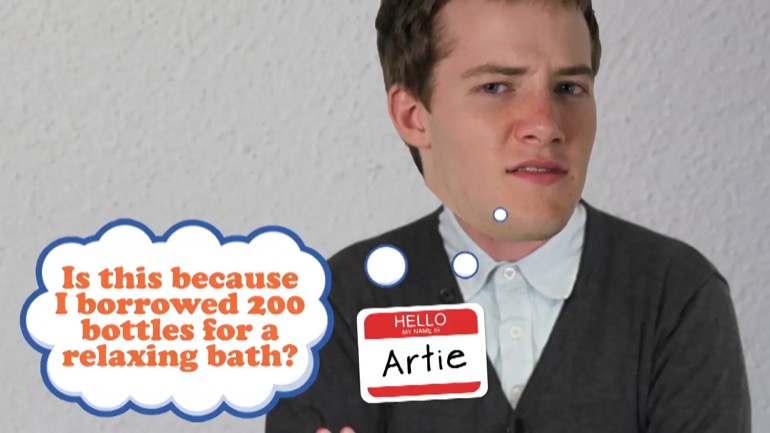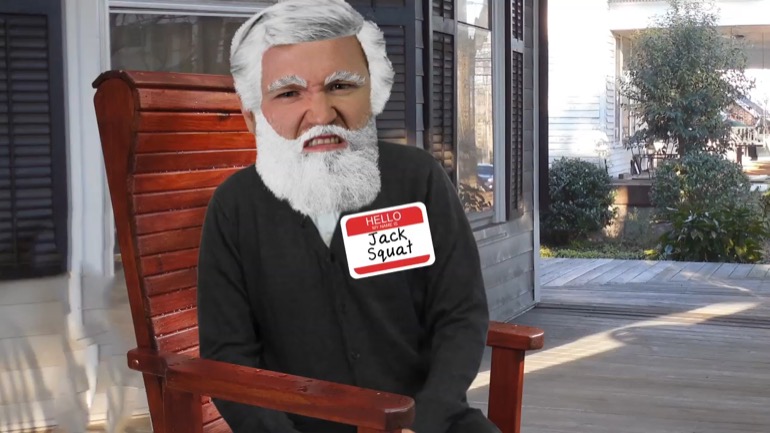ShmoopTube
Where Monty Python meets your 10th grade teacher.
Search Thousands of Shmoop Videos
Principles of Finance Videos 166 videos
How is a company... born? Can it be performed via C-section? Is there a midwife present? Do its parents get in a fight over what to name it? In thi...
Company Formation, Structure, and Inception: Unit Intro. Sorry, Leo DiCaprio fans—we're not going to be breaking down the plot of Inception. We'r...
Okay, so you want to be a company financial manager. It's basically up to you to make money for the shareholders. It would also be swell if you mad...
Principles of Finance: Unit 5, Uncle Sam’s Debt 2 Views
Share It!
Description:
Time to learn about Uncle Sam's debt...but sadly, we'll get no insight as to his fashion choices.
Transcript
- 00:00
llooprinciples of finance a la shmoop Uncle Sam's debt treasure it's not just
- 00:08
for pirates anymore however we're not talking about those big bins of booty [pirate with parrot takes treasure out of chest]
- 00:13
but US federal bonds aka Uncle Sam's debt and yes it's a stretch but federal [bond on a table]
- 00:19
bonds are known as Treasuries at least in pirate circles they're backed by The
- 00:24
Full Faith and Credit of the US ie our ability to tax our hard-working citizens [money being processed]
Full Transcript
- 00:29
meaning that Uncle Sam guarantees that every dollar of debt in whatever flavor
- 00:33
it comes he builds denotes bonds and so on will be paid back big uncle can make
- 00:38
this guarantee because he also owns the only bond printing presses for money [bond printing press]
- 00:43
the only legal ones anyway if it had to the government could crank up the
- 00:47
printing presses and literally print money to pay everyone of course it [women printing money]
- 00:51
doesn't guarantee that this money will actually be worth anything if it does
- 00:55
that print too much paper wealth out of thin air and it can end up well not
- 00:59
buying much check out this carton of milk in Zimbabwe it costs two Zimbabwean
- 01:04
dollars in 1957 today it costs sixteen million yeah they got a little carried
- 01:10
away with their printing presses and in reality just to keep things fair and [money printing press]
- 01:14
square the actual paper money like $20 bills tens fibers etc well they
- 01:19
represent a very small fraction of the total dough that Uncle Sam actually [pie chart]
- 01:23
prints meaning that most of the money raised by the government comes in the
- 01:27
form of bonds they sell to the investing public in batches of zillions like one
- 01:33
bond offering can place a little fifty billion dollars in fifteen minutes and
- 01:37
it take the US Mint while an awfully long time to print that much in 20s but
- 01:41
Uncle Sam's financial cooking comes in a few flavors let's cruise them here just [money thrown onto a skillet]
- 01:45
so everyone's on the same red white and blue page well first up Treasury bonds
- 01:50
Treasuries are referred to by different names depending on the duration or their
- 01:53
maturity let's start with tea bills here short maturity like ours here in the
- 01:58
shmoop writing stable of eleven-year-old their longest maturity is one year but [child typing on laptop]
- 02:02
while most of them are three and six month maturities technically 91 and
- 02:07
82 days accountant well these are very actively traded in secondary markets [money passing hands in alley]
- 02:12
their liquidity is immense so much so that tea bills are considered to be the
- 02:16
equivalent of cash on balance sheets because of their safety and liquidity
- 02:20
yields are very low like you don't get much interest for owning them also [writing on white board]
- 02:25
t-bills don't carry any stated interest rate rather they're sold at a discount
- 02:30
meaning that you pay less than their face value at maturity you receive the
- 02:34
entire face value and the difference between the face and what you paid is
- 02:38
considered the interest or appreciation ie you Biman two dollars and then six
- 02:45
months later they pay you a grand so that eighteen bucks and appreciation
- 02:48
that's considered interest or Lutz's tax that ways ordinary income in this
- 02:52
respect tea bills are the only federal zero coupon bonds
- 02:56
next stop tea notes well these bonds carry a stated interest rates actually
- 03:00
an interest rate number on the face of them the maturity is medium-term and tea
- 03:04
notes are issued n maturities of two three five seven and ten years interest
- 03:08
is paid every six months like a normal bond the sharp-eyed among you might have
- 03:12
noticed that there is a gap between the one year maximum tea bill and the two [t-bill and t-note on table]
- 03:16
year tea note no that's not a typo there's no maturity offered between one
- 03:21
and two years and we have no idea why okay next
- 03:24
tbonz oh wait that's a tea bond so because we had a typo there in the
- 03:28
script to get rid of the e there should be a deep anything with a maturity
- 03:31
longer than 10 years is called a tea bond for a long time the Treasury [writing on white board]
- 03:35
30-year bond was the benchmark for all long-term bonds right it's called just
- 03:40
the 30 because it was so popular well the government discontinued their
- 03:44
issuance in the 1990s but demand was so great that the government reinstituted
- 03:48
them it was a big oops well lastly show us your tips wait what [bond does strip tease]
- 03:52
does that mean tea notes and tea bonds do not adjust for inflation and
- 03:56
inflation risk is one of the risks that investors assume in purchasing [writing on white board]
- 04:01
Treasuries right because the interest is so low a lot of times inflation beats
- 04:05
them well inflation over the last decade or
- 04:07
so has been around two and a half percent a year give or take with
- 04:11
government paper hovering right around the same rate well if you're a 40%
- 04:15
marginal tax payer your after-tax return on two and a half percent paper is only [writing on white board]
- 04:19
about one and half percent meaning that you're actually
- 04:22
losing a percent in buying power each year and it's compounded year after year
- 04:27
that you're invested in this kind of government paper so you're losing more
- 04:30
and more as you go along well not everyone in the government is completely
- 04:34
clueless however and the Fed came up with a piece of paper which answers the [government meeting]
- 04:38
above big issue in the form of tips that is Treasury inflation-protected
- 04:42
securities well these bonds carry interest which [writing on white board]
- 04:46
goes up and down based on government stated interest rates avoiding much of
- 04:50
the inflation risk associated with very low interest rate government bonds well
- 04:55
these bonds will typically have maturities of between five and fifteen
- 04:58
years and as the name suggests they adjust in lockstep with inflation so
- 05:02
your purchasing power will be M more or less protected that's the upside the
- 05:07
downside is that the interest rate on tips is usually really paltry so you're
- 05:11
in for the long run and I'll think about equities instead how do you invest in
- 05:15
Treasuries well if you're buying in size like in hundreds of millions of dollars
- 05:19
well you call different dealers and you just get quotes the unwashed masses like
- 05:24
the rest of us can buy them through a normal broker but a cheaper way to do it
- 05:27
is just through an arm of the US Treasury called Treasury direct recall [website]
- 05:31
that the interest that any bond pays is called the coupon and it's expressed as [writing on white board]
- 05:36
a percentage of the face value and remember that bonds are usually issued
- 05:39
with face values of a thousand bucks so a five percent bond will pay five
- 05:43
percent of a thousand dollars or fifty dollars each year paid in two
- 05:47
installments of twenty five dollars every six months the most issuers come
- 05:51
right out and say what the coupon will be Treasuries do not know the feds like
- 05:56
to toy with investors those back interest rates for Treasuries are set by [uncle sam with a rattle plays with baby]
- 06:00
what's called an auction process think eBay for government bonds know the
- 06:04
details of Treasury auction are way above what you need to know in real life [Ebay website]
- 06:08
and for this course but here are the basics one the Treasury announces that
- 06:11
it'll be auctioning a particular maturities say five hundred million
- 06:14
dollars worth of three year notes interested buyers will then submit the
- 06:19
amount they want to purchase and the yield or interest rate they're willing
- 06:22
to accept all of this is done electronically it's not a physical [hands typing]
- 06:25
auction where the Treasury secretary drops the hammer and yells I sold to the
- 06:29
lady in the fish at three on auction day the Treasury opens the submitted bids
- 06:33
and then parcels out the bonds the folks with the lowest yield bids get their
- 06:37
orders filled first followed by the next lowest yield and so on and so on until
- 06:41
all the bonds are sold well if you wonder why it's done based on yield
- 06:45
remember that the price and yield are inverse to each other the lower the [writing on white board]
- 06:49
yield of the higher the price of the bond and the government is trying to pay
- 06:52
the lowest amount of yield that has to to rent money perceived as the safest
- 06:56
debt on the planet everything is priced in the world as a spread to Treasuries
- 07:01
that is whatever Treasuries are paying plus some incremental markup because
- 07:05
well regardless of whom you're lending to it's riskier than US Treasuries so
- 07:09
want to guaranteed but maybe modest retirement yeah all right set sail for
- 07:14
Treasury Island yeah safest pirate island [pirate sailing on ship with parrot]
Related Videos
GED Social Studies 1.1 Civics and Government
What is bankruptcy? Deadbeats who can't pay their bills declare bankruptcy. Either they borrowed too much money, or the business fell apart. They t...
What's a dividend? At will, the board of directors can pay a dividend on common stock. Usually, that payout is some percentage less than 100 of ear...
How are risk and reward related? Take more risk, expect more reward. A lottery ticket might be worth a billion dollars, but if the odds are one in...







































































































